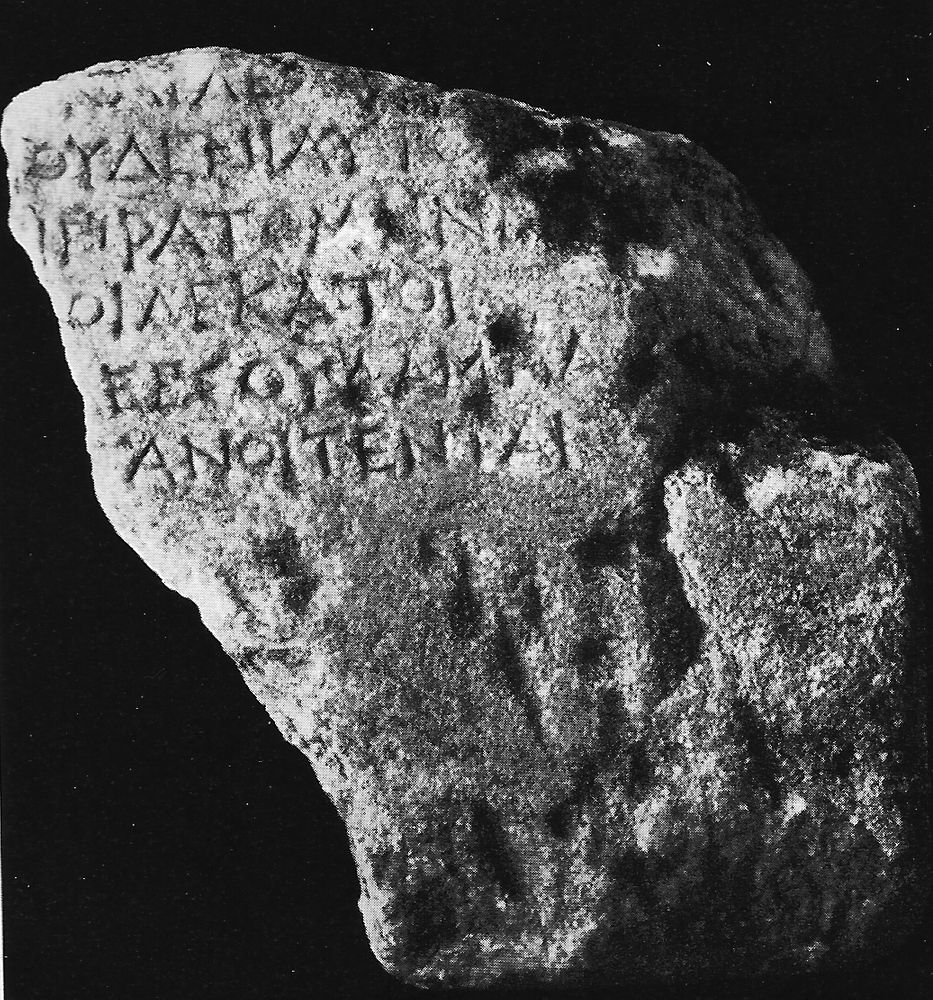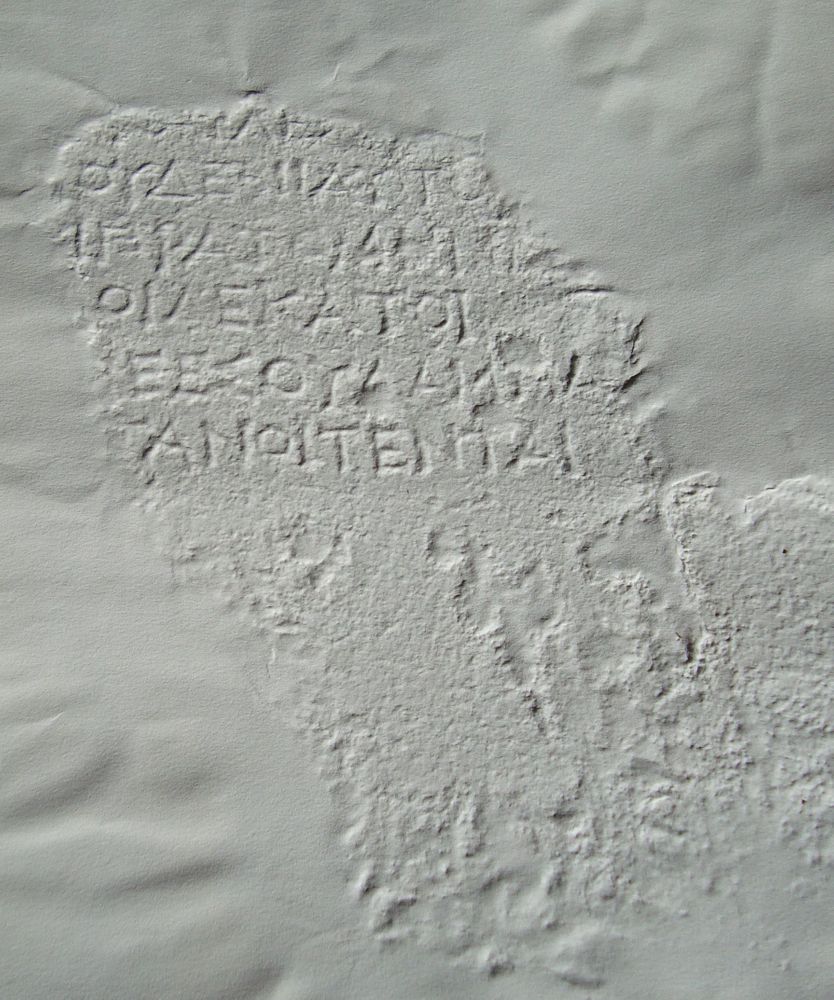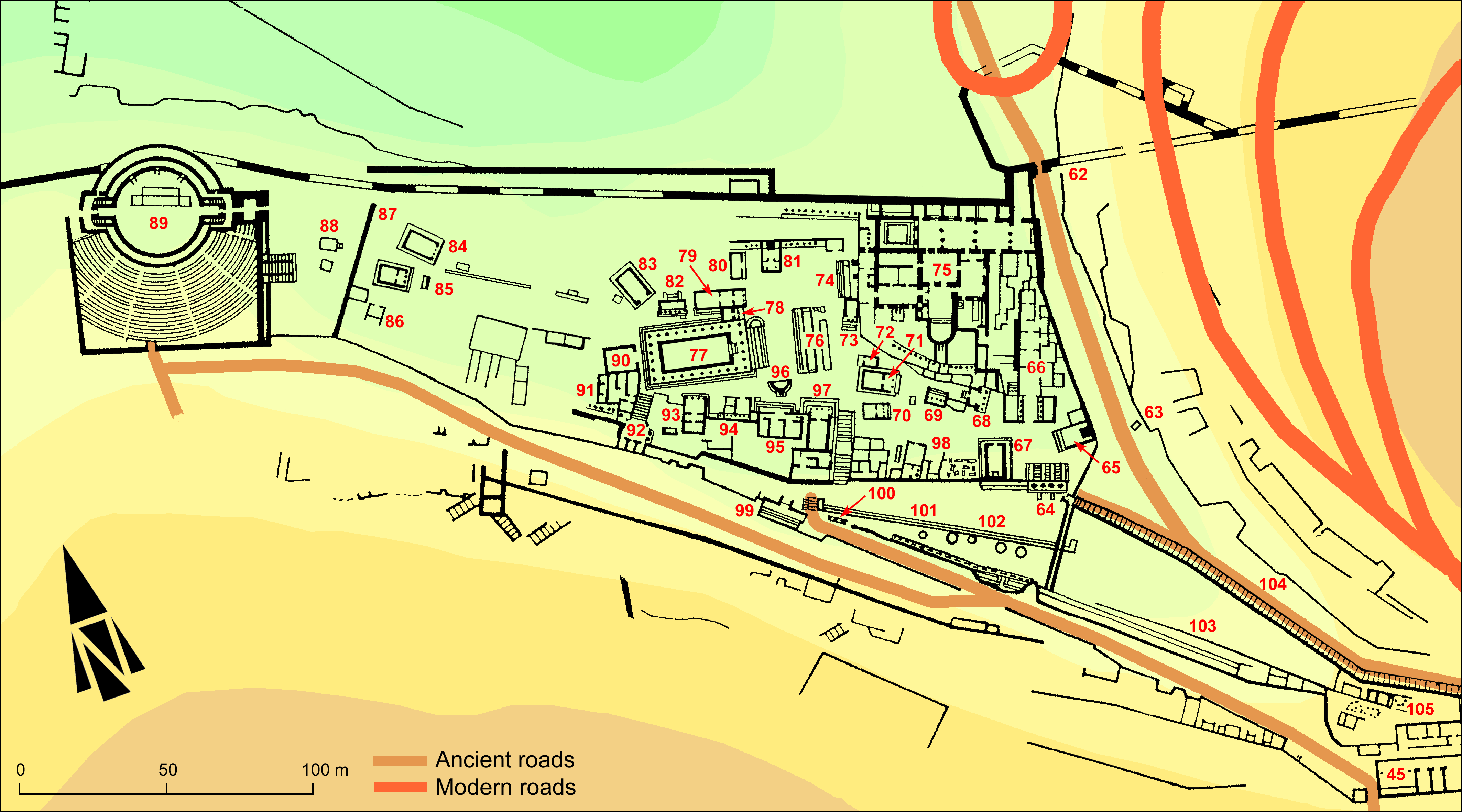EpiDoc XML:
IGCyr1001002
Trismegistos ID:
738518
Source description
Support: Lower right angle of a limestone stele, broken off above, at left and below (w: 0.211 × h: 0.23 × d: 0.13).
Layout: Inscribed on front face.
Letters: 0.01; slight serifs, dotted theta, slightly smaller omicron, slanting sigma, calice-shaped upsilon.
Date: Second half of third century BC
Findspot: Found by G. Oliverio before 1935 at Cyrene ➚: Sanctuary of Apollo, near the Wall of Nicodamos.
Place of origin: Findspot.
Last recorded location: Cyrene Museum, 356. Seen by G. Pugliese Carratelli in 1960 in Shahat: Cyrene Museum. Seen by C. Dobias-Lalou in 1976 at the same place.
Text constituted from: Transcription from stone (CDL).
Bibliography
Oliverio III.35, whence SECir, 157 (photo); IGCyr 100100 ➚; Rosamilia 2023, pp. 276-277, number 22 (text).
Text
Apparatus
1: [---]Κ̣αιλεΑ̣[.. ? ..]: [---]+ΚΑΙΛΕ[.. ? ..] SECir
2: ι̣ οὐδ᾿ἐνιαυτό[ν] IGCyr, Rosamilia 2023: +ου δ᾿ἐνιαυτο[---] SECir
3: [ἐν τᾶ]ι πρατομηνία̣[ι] IGCyr, Rosamilia 2023: +πρατομη̣νία̣[---] SECir
5: [οὐ]δ̣ὲ ἕς Rosamilia 2023: ΛΕΕΣ IGCyr; λ̣εες SECir || οὐ λ̣ᾶμμα: οὐδ̣'ἅμμα SECir, Rosamilia 2023; οὐ λ̣ᾶμμα SECir (meaning 'sacred headband')
6: [---]τᾶν οἱ τένται IGCyr, Rosamilia 2023: +ανοι τένται SECir
French translation
Intraduisible (voir commentaire).
[---] pas même pendant une année [---] le premier du mois [---] les hommes soumis à la dîme [---](5) pas même un. Il n'y a pas pour lui de profit sur les [---] (ou (5) pas même un, ni de lien [---] sera à lui.
English translation
[---] not even during one year [---] the first day of the month [---] the tithed men [---](5) not even one. There will be for him no profit from the [---] (or (5) not even one, nor binder [---] will be for him.
Italian translation
[---] nè per un anno [---] il primo del mese [---] gli uomini soggetti a decima [---](5) nessuno. Non c'è profitto dalle [---] (ou (5) pas même un, ni de lien [---] sarà a lui.
Arabic translation
غير قابل للترجمة بشكل جيد
Commentary
In this very lacunar text, some elements point to the religious practice of the tithe with the mention of men owing a tithe (δεκατοί) at l. 4, which has been the focus. But each detail being much isolated, the whole is far from clear. The only fact which helps is that apparently there is no cutting of words at the end of lines. In the segment ΛΑΜΜΑ at line 5 the first letter is damaged below in the centre and might be taken as a lambda or a delta. Both readings were suggested by Pugliese Carratelli: his preferred one was οὐδ̣'ἅμμα, with a word (related to ἅπτω 'to seize') meaning 'binder', hence 'knot, cord, belt'. He did not explain what concrete meaning he intended there. That knotted garments might be forbidden in some ritual contexts is not quite unexpectable, but, as pointed out by Rosamilia 2023, the elision is not usual in the dialect. Pugliese's second reading was οὐ λ̣ᾶμμα, with, in his opinion, a word of unknown etymology, known only from glossaries, meaning 'headband for suppliants'. However, λᾶμμα is also the Dorian form of λῆμμα (from λαμβάνω), meaning 'income, profit'. From the amount of an income a tithe might be calculated. Choosing one or the other solution is difficult; our choice here rests on Dobias-Lalou's autopsy. What precedes is also obscure. Rosamilia's tantalizing suggestion would produce for the first time the nominative masculine singular of number 'one'. We adopt it now
The mentions of 'year'(l. 2) and 'first day of the month' (l. 3) fit well sacred regulations.
At line 6 ΟΙ can only be the dative of the pronoun of 3sg. It cannot be, as Pugliese Carratelli proposed, the relative at the nominative plural masculine, as the verb 'to be', here at the future, has the 3d person singular. The translations are very tentative.
CC BY-NC-SA 4.0 Deed Attribution-NonCommercial-ShareAlike 4.0 International License.
All citation, reuse or distribution of this work must contain a link back to DOI: https://doi.org/10.60760/unibo/igcyrgvcyr2 and the filename (IGCyr000000 or GVCyr000), as well as the year of consultation.



